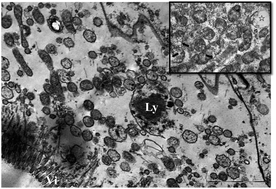Mitochondrial energy metabolism in the hepatopancreas of freshwater crabs (Sinopotamon henanense) after cadmium exposure
Abstract
Energetic homoeostasis is a fundamental requirement in the defense against cadmium (Cd) stress. Using the freshwater crab Sinopotamon henanense as an example, we explored the effects of Cd on submicroscopic structures in hepatopancreatic cells through transmission electron microscopy (TEM) and energy-related parameters such as adenosine triphosphate/adenosine diphosphate (ATP/ADP) ratios, reduced/oxidized nicotinamide adenine dinucleotide (NADH/NAD+) ratios, and the mitochondrial membrane potential (Δψm). The impact of Cd on carbohydrate and protein metabolism, and metallothionein (MT) was also investigated. Experimental 10 day exposure increased NADH and NAD+ and provided a higher NADH/NAD+ ratio and Δψm in hepatopancreatic cells. The corresponding significantly increased levels of ATP and the ATP/ADP ratio in the hepatopancreas supported high energy production. The up-regulation of the MT content in exposed crabs suggests that protein synthesis for detoxification could partially be a major ATP consumer. With increasing exposure time, however, energy production was in decline. Excessive energy consumption was explained by substrate mobilization and mitochondrial impairment. Less carbohydrate and enhanced protein catabolism was observed. Ultrastructurally, there were changes in mitochondria with swelling, membrane disruption, shortening of cristae or the rupture and disappearance of entire mitochondria. The rough endoplasmic reticulum (rER) displayed expansion and membrane rupture, suggesting the destruction of protein-synthesizing structures in hepatopancreatic cells. Our findings suggest that energy-related parameters could be used as biomarkers in the monitoring of metal pollution and quantitative risk assessments of pollutant exposure.


 Please wait while we load your content...
Please wait while we load your content...